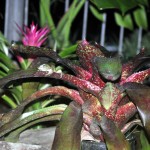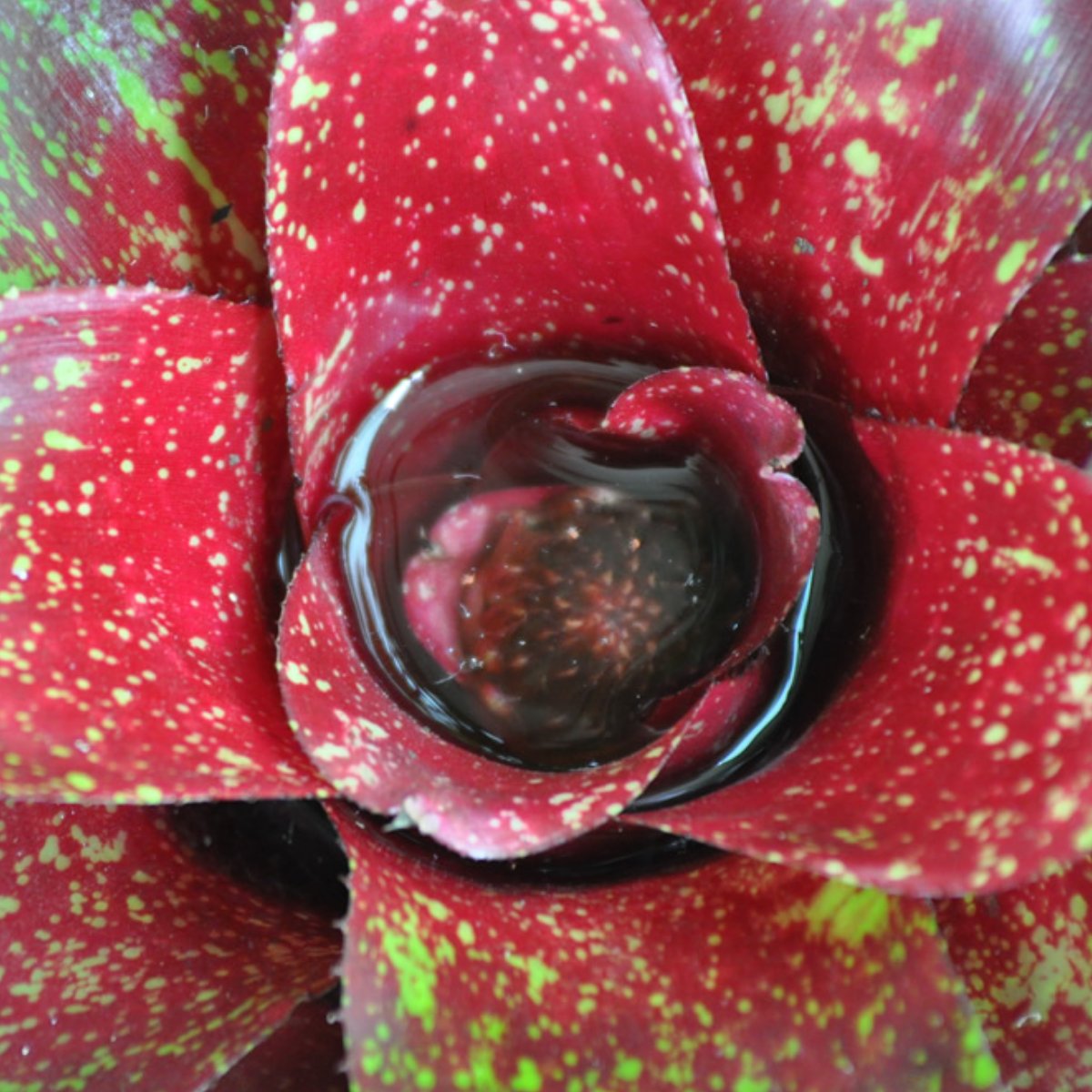Family: Bromeliaceae
Synonymous: Aregelia marmorata
Karatas marmorata
Distribution and habitat: Neoregelia marmorata is an evergreen perennial endemic to Brazil. They can be found from sea level to 1500m (5000 feet), usually growing on trees and shrubs where they receive some shade.
Neoregelia marmorata have a set of leaves that form a water holding cup in the center of the plant. The cup collects water and decaying debris that satisfy the plants nutritional needs when the leaves absorb dissolved nutrients.
Description: Neoregelia marmorata are bromeliads with brilliantly coloured foliage which is arranged in a flattish rosette shape. It has leaves up to 38cm (15 inch) long and about 6cm (2 inch) wide, which are light green heavily marbled on both sides with reddish brown. Flowers are pale lavender-blue, small and contained in the cup. Only a few are open at any given time, but there are many of them, and they open over an extensive period of time.
Neoregelia marmorata are not usually grown for their flowers, but for their leaves. High light levels increases the colouring till the maroon turns wine red and almost glows.
It has no clearly-defined rest period; they normally grow slowly and more or less continuously throughout the year.
Houseplant care: Neoregelia marmorata is not difficult to grow, but it is somewhat more dependent on strong light to develop deep, vivid colors in its leaves. This bromeliad can even withstand some gentle direct sunlight, such as eastern morning exposure.
Light: For compact, briliatly coloured foliage are dependable flowering these plants need bright light with some direct sunlight.
Temperature: Neoregelia marmorata will thrive in normal room temperatures. They cannot tolerate temperatures below about 10C (50F). Provide a humid atmosphere by standing pots on trays of moist pebbles and mist-spray plants daily when they are being grown in warm, dry conditions.
Water: Water the plants moderately, enough to make the potting mixture moist throughout, but allow about one-third of the mixture to dry out between waterings. The cup-like centres of rosettes should also be filled and kept topped up with water; keep this water fresh by carefully upturning the plant about once a month, draining out the old water and replacing it.
Avoid tap water in the central cup if possible and use rain water.
Fertilising: Give Neoregelia marmorata half strength liquid fertiliser every two weeks, applying it not only to the potting mixture but over the foliage and into the centre of the rosette.
Do not overfeed these bromeliads.
Potting and repotting: Use a soil based potting mixture consisting of equal parts of leaf mould, peat moss and sand. Small plants should be moved to pots one size larger in spring. Neoregelia marmorata, however, are unlikely to require pots bigger than 13cm (5 inch) size.
Propagation: Spring is the best time to propagate. Use young rosettes produced near the base of plants or on the ends of stolons. Basal rosettes may already have rooted down into the potting mixture; when carefully detaching them, keep as much root attached as possible. Place each basal rosette in an 8cm (3 inch) pot of a moistened equal-parts mixture of peat moss and sand, enclose it in a plastic bag and keep it in warm place where it will get medium light. After the rosette is well rooted (in about six to eight weeks), transfer it to an 8cm pot (3 inch) of recommended potting mixture for mature Neoregelia marmorata. Thereafter treat it as mature.
Problems: Properly spaced plants growing in a well ventilated area are seldom bothered by disease or insects.
Ifbromeliads are crowded and there is little air circulation scale infestation can develop. The two most common types of scale are the brown soft bodied scale and the black tea scale.
Treatment: A treatment or two of insecticidal soap will usually bring the brown scale under control.
If abromeliad is infected with black tea scale, it can be destroyed and only an appropriate insecticide will eradicate these insects.
Occasionally these bromeliads will be attacked by a fungal disease.
Treatment: Recovery from fungal disease is rapid when treated early with a fungicide.
Usage: Neoregelia marmorata is ideal for landscaping or on a balcony. They require very little maintance and are well suited to shady tropical gardens where a splash of colour is required. Grow this epiphytic bromedliad as a houseplant or in a conservatory in special compost.
SUMMARY:
CHARACTERISTICS:
Foliage coloured
Features flowers
Shape rosette
Height: 30cm (12 inch)
Width: 80cm (31 inch)
PROPER CARE:
Watering in active growth period moderately
Light bright
Temperature in active growth period min 10C max 24C (50-75F)
Humidity high
Hardiness zone: 9b-11





